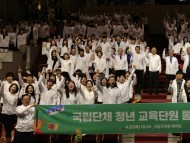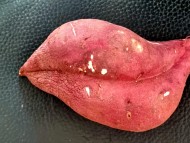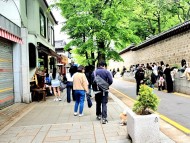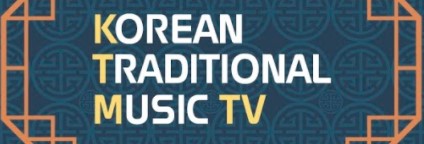2024.05.05 (일)
The National Palace Museum of Korea, Special exhibition Encounter with the Brilliant Scientific Technology of the Joseon Dynasty,>
All 1,755 pieces of artifacts unearthed from the Insadong Excavation Site to meet the public /
November 3rd to December 31st-
- Michael Lammbra…
- 등록 2021.11.03 18:21
- 조회수 419
The National Palace Museum of Korea (Director Kim, In-Gyu) of the Cultural Heritage Administration, together with Sudo Institute of Cultural Heritage (Director Oh, Kyong-Taek), holds a special exhibition under the title Encounter with the Brilliant Scientific Technology of the Joseon Dynasty, from November 3rd to December 31st,. at the Special Exhibition GalleryⅡon the 1st floor of the museum, to exhibit all 1,775 pieces of artifacts excavated at the Insadong site last June. This exhibition is sponsored by LG Household & Healthcare, The Story of Whoo. Since the excavation in June from the Insadong site was reported in the media, the found artifacts received so much attention from the public. This exhibition answers to such enthusiasm and aims to present the relic to the public for everyone to enjoy.
The exhibition is made of two parts. ▲Part 1‘Metal Type of Early Joseon Dynasty Unearthed at the Insadong Excavation Site’, and ▲Part 2 ‘Excavated Artifacts and the Study of Meteorology in Early Joseon Dynasty’.
▲Part 1 greets the visitors with a pottery jar that was found broken, which contained 1600 pieces of metal type. 1300 pieces of metal type that require further research to find out when they were made are exhibited on one side of the exhibition hall. On the other side, other pieces of metal type with known production years are exhibited.
Of the latter group, 48 Metal type of 1434 which was made in 1434 under King Sejong’s orders (Year 16 of King Sejong), 42 Metal type of 1455 (Year 1 of King Sejo) and 214 Metal type of 1465 (Year 11 of King Sejo) are on display. Of the found metal type, Chinese character ‘火’meaning‘fire’and‘陰’meaning‘shadow, silence’can be cross-checked in the Geunsarok (Reflections on Things at Hand近思錄, 1435, Treasure, National Palace Museum of Korea), which is already confirmed to have been printed using the Metal type of 1434. The two letter type‘火’and ‘陰’along with additional 48 metal types with the same form and shape are exhibited alongside the aforementioned book. Metal type of 1455 has been cross-checked against Neungeomgyeong (The Sutra of the Heroic One, 1461, Treasure, Courtesy of Seoul Museum of History) and Metal type of 1465 against Wongakgyeong (The Complete Enlightenment Sutra, 1465, Treasure, Courtesy of Horim Museum), are also displayed in the same manner. At various locations, magnifying glasses and tablets with photos of the artifacts have been placed to invite the visitors to take an even closer look at the small metal type. The Hanging Board of the Type Casting Office, Jujaso and the Hanging Board with the History of Type Casting will also be on display.
▲Part 2 exhibits excavated artifacts that demonstrate the scientific endeavors and the achievements of the early Joseon Dynasty. The most important artifact in this section is the Sun-and-Star Time Determining Instrument, which uses the shadows made by the sun during the day and the stars at night to tell the time. Up until now, the instrument existed only in the records. This excavation brought the instrument back to life. Although one out of the three rings is not complete, we can still envision how it would have looked like when they were in actual use. Next to the newest addition, we also exhibit the Simplified Sundial (National Palace Museum of Korea), which will help the visitors understand how the Sun-and-Star Time Determining Instrument works. The Simplified Sundial is made of three parts; a round ring with time indicating marks around it, a metal base and holder, and a stone pedestal. It is the first time that all three parts of the Simplified Sundial will meet the public. The Internal Component of Self-striking Water Clock was also unearthed. It is a rectangular metal plate with round holes on it in regular intervals. The Self-striking Water Clock has a doll that notifies the time. The discovered component is used to release marbles that will activate the movement of this doll. A video clip showing where the found component belongs to in the Self-striking Water Clock, and how it functions, will be played next to the exhibited artifact.
Among the excavated artifacts from Insadong, one Hand Cannon (1583) and seven small Hand Cannons (1588) will be displayed with a clear description of when they were made, by whom, how much it weighs and how much gun powder it must use; as these facts are engraved on the cannon body. Pieces of a Copper Bell, marked to have been made in 1535, and different types of Metal Coins are also on exhibit.
The finale of the exhibition showcases a video showing how a typical day on the excavation site is like, with the lively voices of the experts who participated in the excavation project. Along the vivid ambiance sounds of the project site, the visitors will also be entertained with special music performed by Park Dawool, who received much attention at a band competition program. Park Dawool composed a new piece of music for this exhibition, embedding the meaning of the found artifacts and the excavation site. In the second week of November, recorded performance by the artist himself in the exhibition hall will be uploaded on the Youtube channels of the Cultural Heritage Administration and the National Palace Museum of Korea.
Additional print material and online content will be provided to make the exhibition viewing experience even more enriching. The exhibition catalog and digital images of the excavated artifacts can be downloaded from the National Palace Museum of Korea’s homepage. And in the second week of November, two more video clips on the behind-the-stage stories of the excavation and the curator’exhibition commentary will be uploaded on the Museum’s Youtube. Special VR showing the entire exhibition hall, explanations of the artifacts and related photos will also be provided.
This exhibition aims to first, bring all of the excavated artifacts to meet the general public, and second, to provide an opportunity for collecting basic data for further investigation and research. We hope you will enjoy this exhibition as you meet the magnificent scientific artifacts from early Joseon that have finally come to shine
- [] 제6회 울진금강송 전국국악경연대회(06/08)
- [] 제29회 대통령상 한밭국악전국대회(07/06-07) (무용/기악/성악)
- [] 제8회 목담 최승희 전국국악경연대회(06/01) (판소리,기악)
- [] [서울]제28회 전국판소리경연대회(06/15-16)
- [] 제32회 대전전국국악경연대회(06/01-02)
- [] 제16회 순천 낙안읍성 전국가야금병창경연대회(05/25-26)
- [] 제18회증평국악경연대회(05/11)
- [] [군산]제32회 전국청소년민속예술경연대회(05/18)
- [] 제42회 전주대사습놀이 학생전국대회(5/18∼6/2)
- [] 제50회 전주대사습놀이 전국대회(5/18~6/3)
- [] 제20회 전국대금경연대회(06/08-09)
- [] 제4회 함양 전국국악경연대회(05/12)
- [] 제18회 대한민국 전통예술무용·연희대제전(06/09)<br>무용(전통무용…
- [] 제48회 부산동래 전국전통예술경연대회(06/15-16)(무용.기악)
- [] [부여]제1회충남전국청소년국악경연대회(05/04)(판소리.기악.타악)
- [] [광주]제21회 대한민국 가야금병창대제전(06/16)
- [] 제18회 과천전국경기소리경창대회(05/04)
- [] 제11회 곡성 통일전국종합예술대전(06/15-16)(판소리.무용, 기악,…
- [] 제24회 인천국악대제전 전국국악경연대회(05/25-26)
- [] 제26회 창원야철전국국악대전(07/06- 07)
- [] 2024 무안장애인 승달국악대제전(06/01-02)
- [] 제22회 무안전국승달국악대제전(06/01-02)
- [] 제10회 전국공주아리랑민요경창대회(05/26)
- [] 제17회 상주전국국악경연대회(05/19)(성악/무용·연희/기악)
- [] 제10회 전국밀양아리랑경창대회(05/26)
- [] 제21회 강남전국국악경연대회(05/22)(무용/타악/판소리/민요)
- [] 제26회 서편제보성소리축제 전국판소리 고수 경연대회(05/04-05)
- [] [순천]제10회 낙안읍성 전국 국악대전(04/27-28)
- [] 제29회 안산전국청소년국악경연대회(05/26)
- [] 제26회(통합58회) 여수진남전국국악경연대회(05/18-19)
- [] 제51회 대한민국 춘향국악대전 경연대회(05/05)(05/11-12)
- [] 제33회 고령전국우륵가야금경연대회(04/26-27)
- [] [부평]제8회 전국 청소년국악경연대회(05/11)(관악/현악/성악)
- [] 제22회 구례전국가야금경연대회(05/04-05)
- [완도]제24회 장보고국악대전 전국경연대회(05/05-06)(무용/판소리…
- [] 제23회 대한민국 빛고을 기악대제전(05/25-26)
- [] [인천] 제10회 계양산국악제(04/26-27) (풍물,사물, 기악,민요…
-

[수요연재] 한글서예로 읽는 우리음악 사설(191)<br>원주아리랑
원주아리랑을 쓰다. 한얼이종선 (2024, 한지에 먹, 40× 63cm) 아침에 만나면 오라버니요 밤중에 만나면 정든 님 일세...
-

[금요연재] 도자의 여로 (143) <BR> 백자철화편병편과 수물(受物)편
같은 백자가마터 출토품이라는 것도 이규진(편고재 주인) 편병은 병을 만든 후 앞과 뒤를 누르거나 두드려 면을 만든 그릇이다. 조선 전기부터 후기까지 지속적으로 만든 기...
-

[국악신문] 정창관의 ‘국악-신반’ <21>
윤하림 해금풍류 II 산조 윤하림 해금풍류 II 산조. (2024년 Sound Press 음반번호없음) 2023년 윤하림 ...
-

[국악신문 소장자료] (42)아리랑 최초 취입 아리랑, ‘1913년 京城卵卵打令’
일본 니포노폰 취입 조선민요 ‘경성란란타령’, 1913년 Nipponophone 6170 SP음반.(국악신문 소장자료) ...
-

[Pick리뷰] 경성 모던걸들의 춤판 '모던정동'…"자유 갈망하는 모습 담아"
30일 서울 중구 국립정동극장에서 열린 국립정동극장예술단 정기공연 '모던정동' 프레스콜에서 출연진이 주요 장면을 시연하고 있다. 2024.4.30 ...
-

세실풍류, 박병천의 '구음시나위'에 허튼춤 선사한 안덕기
국립정동극장이 4월 한달간 진행하는 '세실풍류 : 법고창신, 근현대춤 100년의 여정'에서 23일 박병천의 '구음시나위'에 허튼춤 추는 안덕기 (사진=국립정...
-

세실풍류, 동해별신굿 민속춤사위를 제해석한 조재혁의 '현~'
국립정동극장이 4월 한달간 진행하는 '세실풍류 : 법고창신, 근현대춤 100년의 여정' 에서 조재혁의 '현~' 공연 모습. (사진=국립정동극장). 2024....
-

[Pick리뷰] 이호연의 경기소리 숨, ‘절창 정선아리랑!’
# ‘이호연의 경기소리 숨’ 공연이 지난 4월 26일 삼성동 민속극장 ‘풍류’에서 열렸다. 20대에서 60대까지의 제자들 20명과 5명의 반주자와 함께 경기잡가, 경기민요, 강원도...
-

[PICK인터뷰] 미리 만나 보는 '제94회 남원춘향대전'
[국악신문 정수현 전문기자]=대한민국에서 가장 오래된 축제로 손꼽히는 남원춘향대전(남원춘향제)이 오는 5월 10일(금)부터 5월 16일(목)까지 7일간 남원시 광한루원 일대에서 열...
-

[Pick리뷰] 모던연희극 ‘新칠우쟁론기’
4월 18일부터 20일, 남산국악당에서 아트플랫폼 동화의 모던연희극 ‘新칠우쟁론기’가 펼쳐졌다. [국악신문 정수현 전문기자]=지...
-

[PICK인터뷰] 국립국악관현악단의 채치성 예술감독을 만나다
[국악신문 정수현 전문기자]=봄비가 촉촉이 땅을 적시는 4월, 국립국악관현악단 예술감독으로 취임한 지 6개월이 된 채치성 예술감독님을 만났다. 그는 국악방송 사장, KBS 국악관현...
-

[Pick리뷰] 이 시대의 새로운 춘향가- ‘틂:Lost&Found’
2024 쿼드초이스_틂 (사진=서울문화재단 대학로극장 쿼드 나승열) [국악신문 정수현 전문기자]=대학로극장 쿼드의 ‘쿼드초이스’...
-

[Pick리뷰] 세 악단의 조화로운 하모니, ‘하나 되어’
지난 4일, 국립국악원은 국립국악원 창작악단, KBS국악관현악단, 전북특별자치도립국악원 관현악단 118명으로 구성된 연합 관현악단 무대 ‘하나되어’를 국...
-

[인터뷰] 김경혜의 '시간의 얼굴' 작품전, 16일 개막
칠순을 넘어서는 길목에서 중견작가 김경혜(영남이공대 명예교수) 작가의 열번째 작품전이 오는 16일부터 25일까지 10일간 대구시 중구 슈바빙 갤러리에서 열린다.전시되는총 50여 개...






























